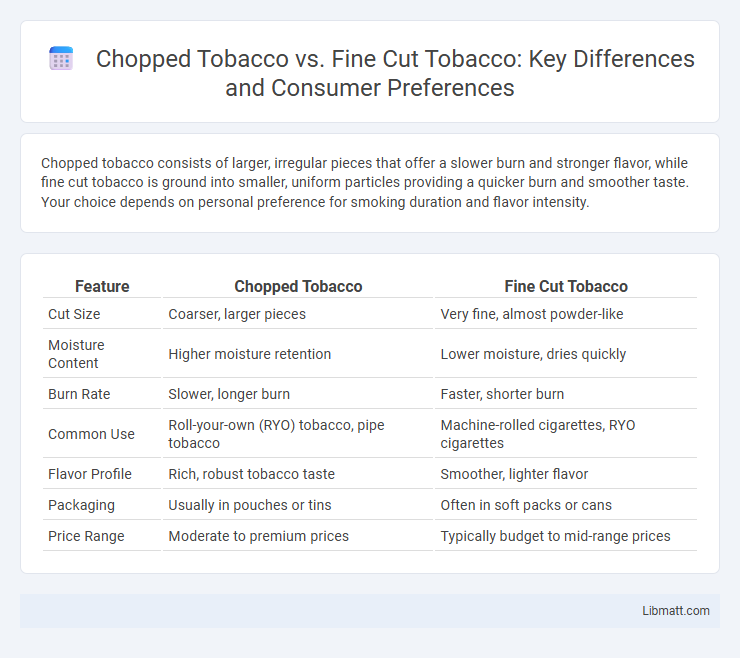Chopped tobacco consists of larger, irregular pieces that offer a slower burn and stronger flavor, while fine cut tobacco is ground into smaller, uniform particles providing a quicker burn and smoother taste. Your choice depends on personal preference for smoking duration and flavor intensity.
Table of Comparison
| Feature | Chopped Tobacco | Fine Cut Tobacco |
|---|---|---|
| Cut Size | Coarser, larger pieces | Very fine, almost powder-like |
| Moisture Content | Higher moisture retention | Lower moisture, dries quickly |
| Burn Rate | Slower, longer burn | Faster, shorter burn |
| Common Use | Roll-your-own (RYO) tobacco, pipe tobacco | Machine-rolled cigarettes, RYO cigarettes |
| Flavor Profile | Rich, robust tobacco taste | Smoother, lighter flavor |
| Packaging | Usually in pouches or tins | Often in soft packs or cans |
| Price Range | Moderate to premium prices | Typically budget to mid-range prices |
Understanding Chopped Tobacco: Definition and Characteristics
Chopped tobacco consists of small, irregular pieces of tobacco leaves, typically used for roll-your-own cigarettes and pipe smoking due to its coarser texture compared to fine cut. Its larger particle size allows for slower burning and a richer flavor profile, appealing to users seeking a traditional smoking experience. The moisture content in chopped tobacco is often higher, enhancing its pliability and ease of use in hand-rolling applications.
What Is Fine Cut Tobacco? Key Features Explained
Fine cut tobacco consists of tobacco leaves shredded into very small, uniform pieces designed for use in rolling cigarettes or pipes. This type offers higher moisture content, ensuring smooth burning and enhanced flavor release compared to chopped tobacco, which is cut into larger, uneven strips. Its finely ground texture allows for easier packing and consistent combustion, making it a preferred choice for cigarette roll-your-own products.
Manufacturing Process: Chopped Tobacco vs Fine Cut
Chopped tobacco is produced by cutting whole tobacco leaves into larger, coarse pieces, preserving more of the leaf's structure and moisture content. Fine cut tobacco undergoes a more intensive grinding or shredding process, resulting in smaller, uniformly thin strands that burn more quickly and evenly. Your choice between chopped and fine cut tobacco depends on the desired texture, burn rate, and flavor release in your smoking experience.
Texture and Consistency: A Comparative Analysis
Chopped tobacco features a coarser texture with irregularly sized pieces, providing a rougher consistency that allows for easier airflow during smoking. Fine cut tobacco, by contrast, consists of uniformly smaller, finely shredded strands that produce a denser, smoother burn and a more compact packing experience. Understanding these textural differences helps you tailor your tobacco choice to your preferred smoking method and desired flavor intensity.
Flavor Profile Differences Between Chopped and Fine Cut
Chopped tobacco contains larger, coarser pieces that produce a fuller, richer flavor with slower burning characteristics, enhancing the natural tobacco essence. Fine cut tobacco, with its smaller, more uniform strands, delivers a quicker, sharper taste often perceived as more intense or slightly more aromatic due to increased surface area exposure. These differences affect how the flavor develops during smoking, with chopped tobacco offering a more robust and lasting profile compared to the brisk, immediate flavor impact of fine cut.
Usage and Application: Roll-Your-Own vs Traditional Methods
Chopped tobacco is finely shredded and ideal for roll-your-own (RYO) cigarettes, offering users greater control over cigarette size and packing density, which enhances smoking customization. Fine cut tobacco, while similar in texture, is often preferred in traditional cigarette rolling due to its consistent particle size that ensures even burning and better flavor release. Both types serve different user preferences: chopped tobacco caters to RYO enthusiasts seeking flexibility, whereas fine cut tobacco supports conventional rolling techniques for a smoother smoking experience.
Burn Rate and Smoking Experience Compared
Chopped tobacco burns faster than fine cut due to larger, loosely packed pieces, resulting in a quicker, more intense smoking experience but shorter duration. Fine cut tobacco offers a slower, more controlled burn, producing a smoother and more consistent flavor over time. Choosing between chopped and fine cut affects your burn rate and overall smoking satisfaction based on personal preference for intensity and session length.
Price and Availability: Which Is More Cost-Effective?
Chopped tobacco generally offers a more cost-effective option due to its bulk packaging and lower price per gram compared to fine cut tobacco, which is often sold in smaller, premium portions. Availability varies by region, but chopped tobacco is typically easier to find in large quantities at convenience stores and specialty shops, ensuring better access for budget-conscious consumers. Your choice depends on how frequently you consume tobacco and whether upfront savings or portion control is more important for your needs.
Health Implications: Chopped Tobacco vs Fine Cut Risks
Chopped tobacco and fine cut tobacco both pose significant health risks due to high levels of nicotine and carcinogens, increasing the likelihood of respiratory diseases, cancer, and cardiovascular issues. Fine cut tobacco, often used for roll-your-own cigarettes, tends to burn faster and produce more harmful tar and toxins compared to chopped tobacco, intensifying exposure to hazardous substances. Both forms contribute to addiction and long-term health complications, with fine cut tobacco potentially amplifying the severity of these risks due to its chemical composition and usage patterns.
Consumer Preferences: Market Trends and Popularity
Consumer preferences for chopped tobacco and fine cut vary significantly, with fine cut gaining popularity among younger smokers due to its ease of rolling and smoother burn. Market trends indicate a steady rise in demand for fine cut tobacco, particularly in regions focusing on hand-rolled cigarettes, while chopped tobacco remains favored by traditional users who prefer a coarser texture. Popularity metrics show fine cut dominating retail sales channels, reflecting a shift toward convenience and customization in tobacco consumption.
Chopped tobacco vs Fine cut Infographic

 libmatt.com
libmatt.com